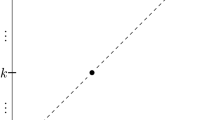Abstract
A model of public good provision by majority rule selection incorporating the behavior of rational group voting is formulated. Two probability maximizing candidates are assumed. If voters are risk averse in public sector preferences, then a unique symmetric (both candidates offering identical platforms) equilibrium exists. If certain additional conditions hold on the group cost functions of political support, this equilibrium will lie at the public good levels which maximizes the sum of voter utility. It is further demonstrated that it is unlikely for those conditions to be satisfied and therefore more realistic asymmetric equilibria with positive voter turnout is predicted.
Similar content being viewed by others
References
Arrow KJ (1963) Social choice and individual values. Yale University Press, New Haven
Austen-Smith D (1985) Interest groups, campaign contributions and spatial voting. Paper presented at the Public Choice meetings in New Orleans, LA
Black D (1948) On the rationale of gorup decision-making. J Polit Econ 56:23–24
Bowen H (1943) The interpretation of voting in the allocation of economic resources. Quart J Econ 58:27–48
Coughlin PJ (1982) Pareto optimality of policy proposals with probabilistic voting. Pub Choice 39: 427–433
Coughlin PJ (1984) Davis-Hinich conditions and median outcomes in probabilistic voting models. J Econ Theory 34:1–12
Coughlin PJ, Hinich MJ (1984) Necessary and sufficient conditions for single-peakness in public economic models. J Pub Econ 25:161–179
Coughlin PJ, Nitzan S (1981a) Directional and local electoral equilibria with probabilistic voting. J Econ Theory 24:226–239
Coughlin PJ, Nitzan S (1981b) Electoral outcomes with probabilistic voting and Nash and social welfare maxima. J Publ Econ 15:113–121
Denzau AT, Parks RP, (1983) Existence of voting-market equilibria. J Econ Theory 30:243–265
Hinich MJ (1977) Equilibrium in spatial voting: The median voter result is an artifact. J Econ Theory 16:208–219
Hotelling H (1929) Stability in competition. Econ J 39:41–57
Kramer GH (1972) Sophisticated voting over multi-dimensional choice spaces. J Math Soc 2:165–181
Kramer GH (1973) On a class of equilibrium conditions for majority rule. Econometrica 41:285–297
Kuttner R (1985) The poverty of economics. The Atlantic Monthly 255:74–84
Ledyard J (1981) The paradox of voting and candidate competition: A general equilibrium analysis. Horwich G, Quick J (eds) Essays in contemporary fields of economics. Purdue University Press, Lafayette 54–80
Ledyard J (1984) The pure theory of large two-candidate elections. Pub Choice 44:7–41
Morton RB (1984a) An interest group model of the strategic calculus of voting. University of New Orleans Division of Business and Economic Research WP 122, New Orleans, LA
Morton RB (1984b) Interest groups and majority voting. Ph. D Dissertation Tulane University, New Orleans, LA (unpublished)
Olson M Jr (1965) The logic of collective action. Harvard University Press, Cambridge
Palfrey TR, Rosenthal H (1983) A strategic calculus of voting. Pub Ch oice 41:7–53
Palfrey TR, Rosenthal H (1984) Participation and provision of discrete public goods: A strategic analysis. J Pub Econ 24:171–193
Palfrey TR, Rosenthal H (1985) Voter participation and strategic uncertainty. Am Polit Sci Rev 79: 62–78
Plott C (1967) A notion of equilibrium and its possibility under majority rule. Am Econ Rev 57:787–806
Riker WH (1980) Implications from the disequilibrium of majority rule for the study of institutions. Am Polit Sci Rev 74:432–446
Slutsky S (1977) A voting model for the allocation of public goods: Existence of equilibrium. J Econ Theory 14:299–325
Slutsky S (1980) Preferences and demands in constrained situations. Department of Economics Tulane University, New Orleans, LA (mimeo)
Author information
Authors and Affiliations
Additional information
This paper is based on an essay of a dissertation submitted to Tulane University under the supervision and invaluable assistance of Steven Slutsky, Jonathan Hamilton, and William Oakland. The advice of Gerald Whitney, Michaels Johnson, and an anonymous referee is also gratefully acknowledged. All errors remain the authors.
Rights and permissions
About this article
Cite this article
Morton, R.B. A group majority voting model of public good provision. Soc Choice Welfare 4, 117–131 (1987). https://doi.org/10.1007/BF00450994
Received:
Accepted:
Issue Date:
DOI: https://doi.org/10.1007/BF00450994




